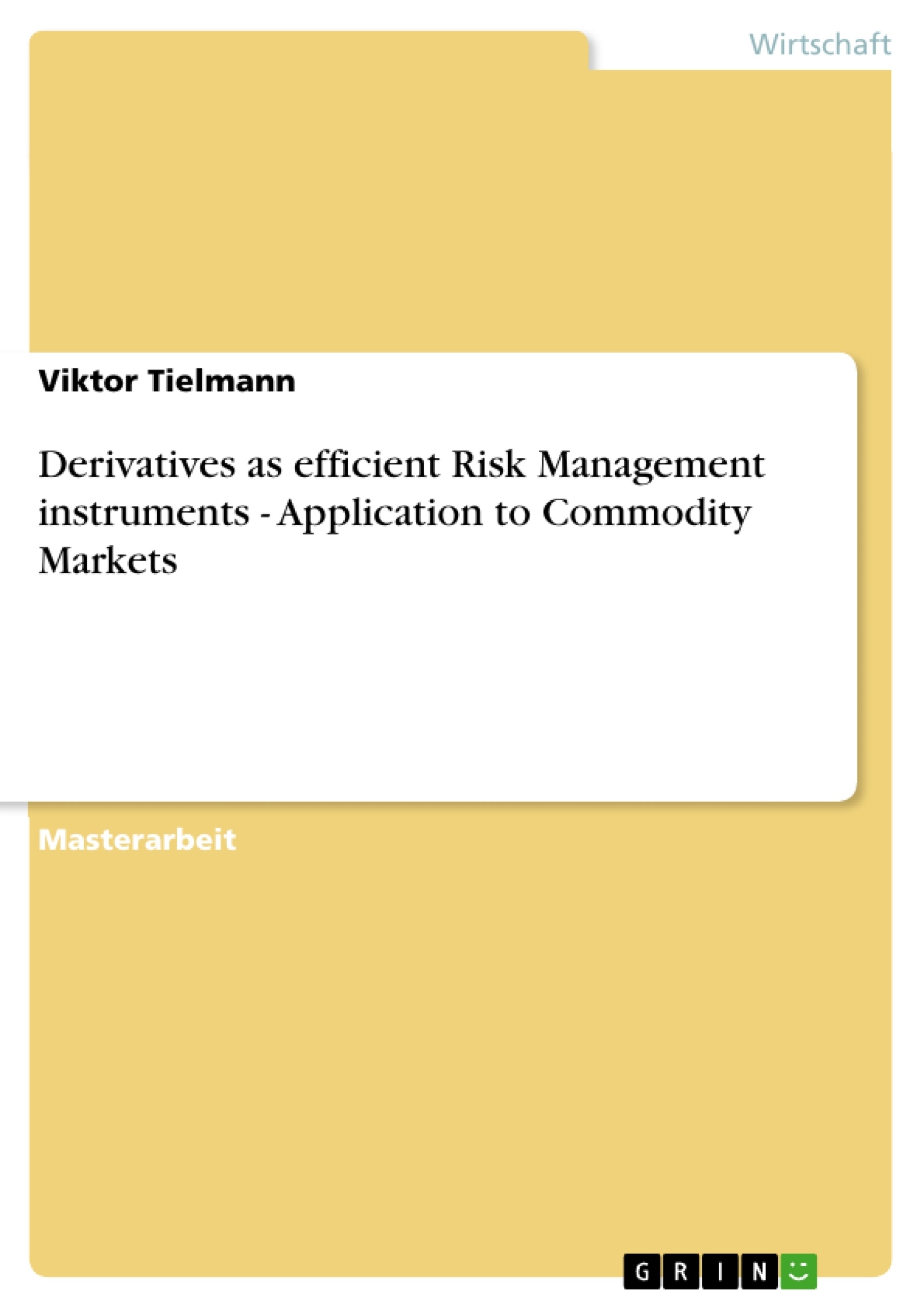The following categorized introduction attempts to give an intelligible overview of the present Master Thesis. At first the purpose of this study will be explained, including the illustration of the importance of a commodity risk management for companies as well as the rising importance of commodity markets. Additionally the stakeholders and objectives will be presented, followed by a comprehensive structure of this Thesis.
Inhaltsverzeichnis
- 1. Einleitung
- 1.1 Zweck der Studie
- 1.2 Stakeholder und Ziele
- 1.3 Struktur der Studie
- 2. Theoretische Grundlagen und Terminologien
- 2.1 Definition des Risikomanagements
- 2.2 Definition des Rohstoffhandels
- 2.3 Risikokategorien eines Unternehmens
- 2.4 Spezifische Rohstoffrisiken und -probleme
- 2.4.1 Marktpreisrisiken
- 2.4.2 Quantitative Risiken
- 2.4.3 Gegenparteirisiken
- 2.4.4 Basisrisiken
- 2.5 Der Risikomanagementprozess
- 2.5.1 Risikoidentifikation
- 2.5.2 Risikobewertung
- 2.5.3 Risikosteuerung
- 2.5.4 Risikokontrolle
- 3. Derivate als Finanzinstrumente
- 3.1 Definition von Derivaten
- 3.2 Forward-basierte Derivate
- 3.2.1 Forwards
- 3.2.2 Futures
- 3.2.2.1 Der Aktienmarkt
- 3.2.2.2 Mark-to-Market
- 3.2.3 Swaps
- 3.3 Optionen
- 3.3.1 Terminologie
- 3.3.2 Der Call
- 3.3.2.1 Der Long Call
- 3.3.2.2 Der Short Call
- 3.3.3 Der Put
- 3.3.3.1 Der Long Put
- 3.3.3.1 Der Short Put
- 3.3.4 Das Cap
- 3.3.5 Der Floor
- 3.3.6 Der Collar
- 3.3.7 Exotische Optionen
- 3.3.7.1 Mehrere Rohstoffoptionen
- 3.3.7.2 Pfadabhängige Optionen
- 3.3.7.3 Compound Optionen
- 3.3.7.4 Binäre Optionen
- 4. Praktische Absicherungsstrategien
- 4.1 Forward-basierte Derivate
- 4.1.1 Absicherung mit Forwards
- 4.1.2 Absicherung mit Futures
- 4.1.3 Absicherung mit Swaps
- 4.1.3.1 Plain Vanilla Swaps
- 4.1.3.2 Cross Commodity Swaps
- 4.1.3.3 Clean Dark Spread
- 4.1.3.4 Spot Basic Swap
- 4.2 Absicherung mit Optionen
- 4.2.1 Put-Optionen
- 4.2.2 Call-Optionen
- 4.2.3 Das Cap und der Floor
- 4.2.4 Der Collar
- 4.2.5 Exotische Optionen
- 4.2.5.1 Pfadabhängige Optionen
- 4.2.5.2 Mehrere Rohstoffoptionen
- 4.2.5.3 Binäre Optionen
- 4.3 Analyse der Vorteilhaftigkeit
- 4.1 Forward-basierte Derivate
Zielsetzung und Themenschwerpunkte
Diese Masterarbeit untersucht die Anwendung von Derivaten als effiziente Instrumente des Risikomanagements in Rohstoffmärkten. Das Hauptziel ist es, die verschiedenen Arten von Derivaten und deren Anwendungsmöglichkeiten zur Absicherung von Rohstoffpreisrisiken zu analysieren und zu bewerten.
- Definition und Anwendung von Derivaten im Rohstoffhandel
- Analyse verschiedener Risikokategorien in Rohstoffmärkten
- Bewertung verschiedener Absicherungsstrategien mit Derivaten
- Vergleich der Vorteilhaftigkeit verschiedener Derivate für das Risikomanagement
- Theoretische Grundlagen des Risikomanagements
Zusammenfassung der Kapitel
Kapitel 1 führt in das Thema ein und beschreibt den Zweck, die Stakeholder und die Struktur der Arbeit. Kapitel 2 erläutert die theoretischen Grundlagen des Risikomanagements und des Rohstoffhandels, einschließlich der Definition verschiedener Risikokategorien. Kapitel 3 beschreibt verschiedene Derivate wie Forwards, Futures, Swaps und Optionen, inklusive exotischer Optionen, detailliert. Kapitel 4 behandelt praktische Absicherungsstrategien mit diesen Derivaten und deren Anwendung in Rohstoffmärkten.
Schlüsselwörter
Derivate, Risikomanagement, Rohstoffmärkte, Hedging, Forwards, Futures, Swaps, Optionen, Preisrisiko, Absicherungsstrategien, Quantitative Risiken, Gegenparteirisiken.
- Citar trabajo
- Viktor Tielmann (Autor), 2011, Derivatives as efficient Risk Management instruments - Application to Commodity Markets, Múnich, GRIN Verlag, https://www.grin.com/document/183519



